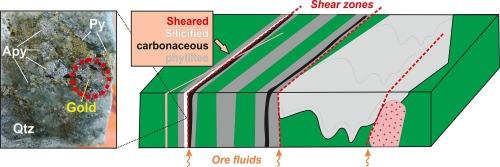Shear-zone related gold mineralisation in silicified meta-sediments: The Paleoproterozoic Overman deposit (Guiana Shield, Suriname)
IF 3.6
2区 地球科学
Q1 GEOLOGY
引用次数: 0
Abstract
The Overman deposit, located near the well-endowed Rosebel gold-mining district in Suriname, is hosted by the Paleoproterozoic Marowijne Greenstone Belt in the north-eastern Guiana Shield. Gold enrichment is centred in a lensoid interval of pervasively silicified rock within a sequence of strongly deformed, predominantly phyllitic meta-sediments of the Armina Formation, considered to be turbiditic in origin. The auriferous silica-body is closely associated with a significant unit of carbonaceous phyllites. The entire sequence experienced greenschist-facies metamorphism with peak temperatures around 500 °C and a polyphase deformation history, comprising an initial phase of tight folding followed by an episode of brittle-ductile shearing. Field relationships and microtextural evidence point to a protracted period of sulphide mineralisation during major shearing, which post-dated peak metamorphism and the silicification event. Arsenic enrichment accompanied the ore forming stage.
Zircon U-Pb dating of host sediment and a crosscutting rhyolitic dyke, in combination with the chronological framework of regional geologic events, indicates that gold mineralisation occurred late in a 2.08–2.03 Ga interval, i.e. towards the end of the D2 stage of the Trans-Amazonian orogenetic cycle. The Overman anomaly is part of a larger sediment-hosted orogenic gold corridor, which coincides with a crustal-scale shear zone, marking the location of Paleoproterozoic oblique collision between crustal blocks. Comparable post-collisional geodynamic conditions were likely instrumental for the emplacement of orogenic gold in metasediments elsewhere in the Marowijne Greenstone Belt. Conspicuous similarities with the major Paleoproterozoic gold deposits hosted by shear zones in turbidites in the Ashanti belt of Ghana are indicative of common genetic controls.

硅化变质沉积物中与剪切带相关的金矿化:苏里南圭亚那地盾古元古代Overman矿床
Overman矿床位于苏里南富庶的Rosebel金矿区附近,位于圭亚那地盾东北部的古元古代Marowijne绿岩带中。金富集集中在阿米娜组的透镜状层序中,该层序中普遍存在硅化岩,主要为千兆基变质沉积物,被认为起源于浊积岩。含金硅质体与一个重要的碳质千层岩单元密切相关。整个层序经历了绿片岩相变质作用,峰值温度在500℃左右,形成了一个多阶段的变形史,包括初始阶段的致密褶皱,随后是一段脆性-韧性剪切。野外关系和显微结构证据表明,在大剪切作用期间,硫化物矿化时间较长,晚于峰值变质作用和硅化事件。成矿阶段砷富集。结合区域地质事件的年代学框架,结合主沉积物和横切流纹岩脉的锆石U-Pb定年,表明金矿成矿发生在2.08-2.03 Ga区间晚期,即跨亚马逊河造山旋回D2期末期。Overman异常是一个较大的含沉积造山带金走廊的一部分,该走廊与地壳尺度剪切带重合,标志着古元古代地壳块体间斜碰撞的位置。类似的碰撞后地球动力学条件可能有助于在Marowijne绿岩带其他地方的变质沉积物中找到造山金。与加纳阿散蒂带浊积岩剪切带主要的古元古代金矿床有明显的相似性,表明它们具有共同的成因控制。
本文章由计算机程序翻译,如有差异,请以英文原文为准。
求助全文
约1分钟内获得全文
求助全文
来源期刊

Ore Geology Reviews
地学-地质学
CiteScore
6.50
自引率
27.30%
发文量
546
审稿时长
22.9 weeks
期刊介绍:
Ore Geology Reviews aims to familiarize all earth scientists with recent advances in a number of interconnected disciplines related to the study of, and search for, ore deposits. The reviews range from brief to longer contributions, but the journal preferentially publishes manuscripts that fill the niche between the commonly shorter journal articles and the comprehensive book coverages, and thus has a special appeal to many authors and readers.
 求助内容:
求助内容: 应助结果提醒方式:
应助结果提醒方式:


